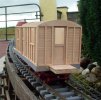Eaglecliff
Registered
I'm using 3-inch wide basswood sheet 1/16th thick to construct a vertically planked stock car. The planks will be scored into the wood lengthwise in sections rather than cut individually. Unfortunately, the basswood, which I have had for a while, is gently curving with its own grain. There will be some horizontals glued across the grain , also 1/16th but from 1/16th by 1/4 stock, which should help but I'm not convinced they will overcome the curvature . Is there any means whereby I can flatten the wood, e.g., dampening it, weighting it and leaving it to dry?

